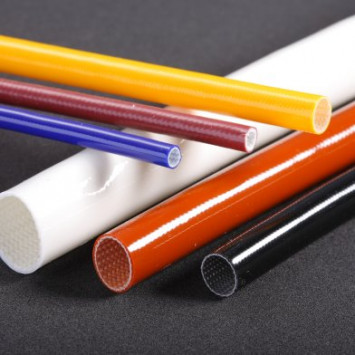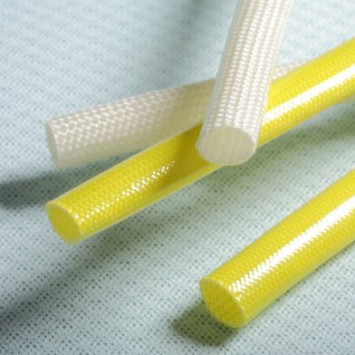The Ultimate Guide to Fiberglass Sleeving for Electrical Protection.
2023-03-14|
Table of contents: |
▲GOODGI Taiwan fiberglass sleeving Manufacturing Line.(Watch more on the GOOD GI Insulation Sleeves YouTube channel.)
What is Fiberglass Sleeving?
Fiberglass sleeving is a highly versatile and durable external protective material made of woven fiberglass. It is commonly used in industrial production, household appliances, energy, and other fields to protect pipes, cables, wires, and other equipment. Fiberglass sleeving is made by weaving glass fibers into a tubular shape with different wall thicknesses, diameters, shapes, and surface treatments to suit various application environments. Its high-temperature resistance, corrosion resistance, fire resistance, and insulation properties make it an ideal solution for protecting equipment from damage and wear and tear. Moreover, fiberglass sleeving is a cost-effective choice as it offers long-lasting protection, reducing maintenance costs and downtime in industrial settings. If you require reliable and long-lasting protection for your equipment in high-temperature or electrical environments, consider using fiberglass sleeving.
Advantages
-
High temperature resistance
Fiberglass sleeving can withstand high temperatures, making it ideal for use in high-heat environments.
-
Electrical insulation
Fiberglass sleeving provides excellent electrical insulation, protecting wires and cables from electrical current and preventing electrical interference.
-
Chemical resistance
Fiberglass sleeving is highly resistant to chemicals, making it ideal for use in harsh chemical environments.
-
Durability
Fiberglass sleeving is highly durable and can withstand abrasion, bending, and fraying, providing long-lasting protection for wires and cables.
-
Flexibility
Fiberglass sleeving is flexible and can conform to the shape of wires and cables, making it easy to install and providing a snug fit.
-
Cost-effective
Fiberglass sleeving is a cost-effective solution for wire and cable protection, providing excellent performance at a relatively low cost.
Industries That Use
-
Electrical and electronic industry
Used for insulating wires and cables in equipment like transformers, motors, and generators.
-
Automotive industry
Protects wires and cables in engine compartments, fuel systems, and braking systems.
-
Aerospace industry
Safeguards wires and cables in aircraft engines, avionics, and other critical systems.
Coated
-
Non-coated fiberglass sleeving
Non-coated fiberglass sleeves are suitable for applications where high temperature resistance and excellent insulation performance are required, but chemical or abrasion resistance is not a concern.

-
Silicone coated fiberglass sleeving
This type of sleeving is commonly used in high temperature applications due to its ability to withstand temperatures up to 200°C. It offers good flexibility and is resistant to abrasion and chemicals.

-
Acrylic coated fiberglass sleeving
This type of sleeving is also abrasion-resistant and offers good mechanical and chemical resistance. It can withstand temperatures up to 155°C.

-
Polyurethane (PUR) coated fiberglass sleeving
This type of sleeving is highly abrasion-resistant and offers excellent mechanical and chemical resistance. It is commonly used in industrial applications .
-
Polyvinyl chloride (PVC) coated fiberglass sleeving
PVC coated fiberglass sleeving is highly flexible, chemical-resistant, and abrasion-resistant, making it an ideal choice for protecting wires and cables in automotive and electronic applications.
Selection Criteria
-
Operating Temperature
To ensure proper protection and functionality, it's important to select the right fiberglass sleeving based on its operating temperature. Fiberglass sleeving is commonly used in high-temperature environments, such as in industrial production or electrical applications, where it is exposed to extreme heat and potential damage. When selecting a fiberglass sleeve, it's important to consider its temperature rating, which indicates the maximum temperature at which it can operate safely for a prolonged period of time.
If the fiberglass sleeve is made solely from woven fiberglass without any coatings or insulation, it can withstand high temperatures of 500°C or more without becoming brittle, as seen in products such as Good Gi's HTG series. However, if the sleeve is coated with other materials for specific properties, such as silicone for flexibility or acrylic for abrasion resistance, the temperature rating will depend on the coating material's properties. For example, a fiberglass sleeve coated with silicone may become brittle and damaged when used in an environment exceeding 200°C.
It's important to select a fiberglass sleeve with a temperature rating that matches the ambient temperature of its operating environment. Choosing a sleeve with a lower temperature rating may result in melting or damage to the sleeve, leading to insulation failure and other performance issues. By selecting the right fiberglass sleeve based on its temperature rating, you can ensure the safety and longevity of your equipment. -
Oil Resistance of Fiberglass Sleeving
When selecting fiberglass sleeving for use in oil-immersed electrical equipment such as transformers and motors, particular attention must be paid to its oil resistance and long-term stability. These types of equipment operate for extended periods in environments filled with electrical insulating oil. If the sleeving material is not resistant to such oils, it may degrade over time, leading to a decline in insulation performance and potentially compromising the safety of the entire system.
It is advisable to conduct oil resistance testing based on the actual application environment or refer to standard conditions established by reputable third-party testing organizations. For instance, oil resistance testing in accordance with JIS C 2320 (Japanese Industrial Standard) involves prolonged high-temperature immersion in insulating oil, verifying that the material maintains its physical and electrical properties. This indicates that the material is well-suited for long-term use in oil-immersed electrical systems.
Therefore, when choosing fiberglass sleeving, it is recommended to prioritize products that have passed oil resistance tests and meet the JIS C 2320 standard, ensuring reliable durability and safety in real-world applications.
-
Diameter
To ensure proper protection, it is important to choose the right diameter for your fiberglass sleeve. You should measure the diameter of the cable or wire and select a sleeve with an inside diameter that is slightly larger. If the diameter of the sleeve is too small, it may be challenging to install, and the braided layer may open up during the assembly process, reducing its effectiveness. Conversely, if the diameter is too large, the sleeve may slip off the wire or cable easily, leaving it exposed to potential damage. Therefore, selecting the appropriate diameter for your fiberglass sleeve is crucial in ensuring optimal protection for your equipment.
-
Insulation Performance
To ensure proper insulation performance for your equipment, it's important to consider the dielectric strength of the fiberglass sleeving. Dielectric strength refers to the maximum voltage that the sleeving can withstand without breaking down. Generally, higher dielectric strength indicates better insulation performance.
Fiberglass sleeving can be categorized into different levels of insulation performance based on the environment or wiring harness design requirements. These levels include 1500V, 2500V, 4000V, and 7000V.
Good Gi's GF series of silicone fiberglass sleeving has undergone testing and meets the UZFT2-Grade A level for insulation performance, as verified by the UL-UZFT2 test. Choose a high-quality fiberglass sleeving product like this to ensure reliable and effective insulation for your equipment. -
Abrasion resistance
To enhance the abrasion resistance of fiberglass sleeving, coatings such as polyurethane (PUR) or acrylic are often used. These coatings can provide a higher level of protection against wear and tear compared to silicone coatings.
When selecting fiberglass sleeves for environments where abrasion is a concern, it is important to consider the potential for contact with rough surfaces, sharp edges, or other abrasive materials. A sleeve with higher abrasion resistance is likely to last longer and provide better protection in such environments.
At Good Gi, we offer a range of fiberglass sleeving products that have been specifically designed to provide superior abrasion resistance, such as our HTG series with a polyurethane coating. These products have been tested and proven to withstand tough environments and provide long-lasting protection for wires and cables. -
Flexibility
It is crucial to select a fiberglass sleeve that is flexible enough to bend and conform to their shape. Good Gi uses high-twist fiberglass yarns and tight weaving to enhance the flexibility and resistance to flex fatigue of its fiberglass sleeves. Additionally, the sleeves are coated with a soft material to further increase their flexibility. This allows the sleeve to easily bend and move along with the wire or cable, preventing damage from occurring due to sharp bends or twists. By selecting a flexible fiberglass sleeve, you can ensure reliable and long-lasting protection for your equipment.
In conclusion, the selection of fiberglass sleeving plays a crucial role in ensuring the safety and reliability of electrical systems. It is important to consider various factors, including temperature rating, insulation performance, diameter, abrasion resistance, chemical resistance, and flexibility, when choosing a suitable fiberglass sleeve. By carefully assessing these factors, you can ensure that you select the right fiberglass sleeve that can meet your specific needs and provide optimal protection for your wires and cables.
Thank you for considering our fiberglass sleeving solutions for your equipment wire and cable protection needs. Our high-quality fiberglass sleeves provide reliable protection in a wide range of industries, including electrical and electronic, automotive, and aerospace. If you're interested in learning more about our products or would like to request a quote, please don't hesitate to contact us. We are here to help.